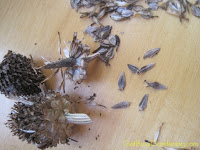Save Seeds Now for Next Year
 Gardeners who save seed from their favorite flowers, herbs and vegetables from year to year are ensuring that their garden will please them. The seeds we choose to save are our favorite variety from the best plants, which means that they will be an improvement on the ones purchased.
Gardeners who save seed from their favorite flowers, herbs and vegetables from year to year are ensuring that their garden will please them. The seeds we choose to save are our favorite variety from the best plants, which means that they will be an improvement on the ones purchased.
Of course, money is saved by collecting your own seeds particularly if you usually purchase specialty seeds by mail order and add in the shipping costs.
Over years of saving only the best, the seeds available for the next season’s garden will produce top quality heirloom plants that are acclimated to your weather, water availability and climate, plus GMO-free.
Save the seeds of plants with the qualities you prefer: Color, disease resistance, when they bear flowers or fruit, insect protection, size, length of storage in vase or basement, texture and yield.
Annuals are the easiest to save. Snip and save the seed heads of zinnias, cosmos, marigolds, petunias, columbine, dill, parsley, lettuce, kale, chard, leeks, etc. If the seeds you originally purchased were of hybridized plants, the seeds you collect probably will revert back to one of the parents so it is more rewarding to use seeds from non-hybrid varieties.
If there is an annual growing in the garden now that you would like to have again next year because of its height, fruit size, insect resistance or yield, mark it with a tag of some kind so you remember not to cut it for a vase or cook with it.
Seeds that are gathered too early will not be mature enough to produce plants next year. If you are saving vegetable seed, the fruit has to be completely ripe in most cases though slightly immature seeds of beans, tomatoes, and leaf vegetables are often viable.
Fleshy fruit such as cucumber, squash, and pepper should be completely ripe. Tomatoes should be soft, cucumbers yellow and peppers red. On the other hand, once fruit has rotted, the seeds are deteriorated and useless.
After the seeds are collected they have to be cleaned, sorted, dried and carefully stored. For home gardeners this process can be done on a clear, dry day sitting outside or at the kitchen table.
Tomato seeds have their own requirements but it is worth the trouble if you have an especially good tomato that you want to grow again. Soak tomato seeds for a few days to ferment them. The good seeds will sink to the bottom of the container and the poor seeds will float to the top. Cucumber seeds can be treated the same way.
Seeds must be completely dry before storing. After cleaning out the chaff, air-dry the seeds on newspaper for a week or two and change the paper once or twice a week. Large seeds of peas and beans can take 2 weeks to dry thoroughly.
Storing seed correctly will keep them alive and inhibit sprouting. Many gardeners keep their saved seed in the vegetable drawer of the refrigerator. If the seeds are completely dry, many types can be stored in a home freezer.
Store the thoroughly dry seeds in glass jars with tops or in envelopes stored in glass jars. Mark each envelope or jar with the plant name before storing.
Baby food jars and others with a small rubber gasket are ideal because they keep out moisture that can damage the life of the seeds. Cans with tight lids work just as well as glass containers.
If saving seeds is new to you, start with something you love. Next year you will have your own heirloom plants to enjoy.






Comments